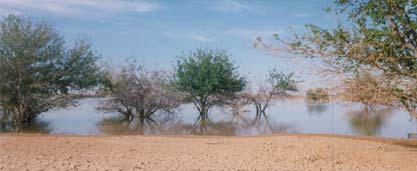|
The region
North Africa is the place where three continents meet, along the Southern shore of the Mediterranean, consisting of five countries: Algeria, Egypt, Libya, Morocco and Tunisia. It extends over 545.3 million hectares and has a population of some 150 million.

98.3% of the area is drylands vulnerable to desertification and the hazards of drought. Land, sea and inland water pollution, over grazing, deforestation and the transformation of oases and valleys into farming or urban areas are some of the other major sources of pressure on natural resources. Low-income rural people in North Africa rely heavily on the direct consumption of biodiversity, including wild foods, medicines and fuels, as well as grazing.
In spite of these conditions, North Africa has important resources of biological diversity. It is the home of plant species that are relatives of livestock and food and fodder crops, and of hundreds of species that are traditional medicinal plants. It is the geographic transition between the warm tropics in the south and the temperate zone in the north, and so forms an important part of the routes for migratory birds. It is also a region of rich cultural and natural heritage, which influences the daily lives of the people as well as one of the historic sources of civilization.

Most of North Africa falls into arid and semi-arid environments; however there is also a range of geomorphologic features and sub-climatic zones which have created diverse ecosystems and extremely rich communities of flora and fauna. The sub-region features vast areas of coastal land and oases in the Sahara, which create diversity of habitat. The sub-region also contains considerable crop biodiversity. About 70% of the wild plants in the sub-region are known to be of potential value. Data for Morocco shows that it has particularly high species diversity and endemism and holds approximately 3,800 species of vascular plant, of which 829 are endemic. Four of these are in danger of extinction and 238 species are directly threatened.
North African countries have signed or ratified most, if not all, of the major international conventions.
These include:
- The Convention on Biological Diversity
- The Convention on Migratory Species
- The Barcelona Convention
- The Ramsar Convention on Wetlands
- The UN Framework Convention on Climate Change
- The UN Convention to Combat Desertification
- The Convention on the Conservation of European Wildlife and Natural Habitats
In addition to international conventions, regional environmental conventions and programmes have been in place since 1976. The first such Convention signed after the World Summit in Stockholm (1972) was the Barcelona Convention of 1975, ratified by all countries in North Africa. The Convention has had numerous legal consequences, namely in supporting and updating legal provisions at the national levels. The first Regional Seas Programme of UNEP (Mediterranean Action Plan - MAP) was established in 1976 to support the implementation of the Convention.
IUCN is present in the region with 20 members, including state, government and NGO. In addition, IUCN has more than 118 commission members of internationally-recognised scientists and experts from the region who volunteer their services to its six global commissions.
|


